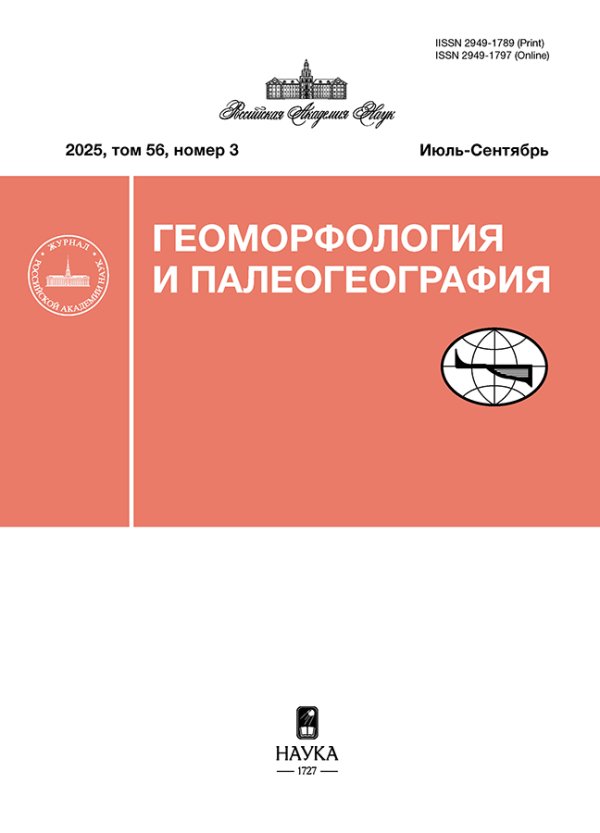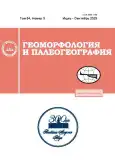THE METHOD FOR CO-REGISTRATION OF DIGITAL TERRAIN DATA TO OBTAIN HYDROLOGICALLY CORRECT MODEL OF THE EARTH’S SURFACE1
- Authors: Kharchenko S.V.1,2
-
Affiliations:
- Lomonosov Moscow State University, Faculty of Geography
- Institute of Geography RAS
- Issue: Vol 54, No 3 (2023)
- Pages: 150-164
- Section: RESEARCH METHODS
- URL: https://journals.rcsi.science/2949-1789/article/view/140589
- DOI: https://doi.org/10.31857/S2949178923030039
- EDN: https://elibrary.ru/VSPGKZ
- ID: 140589
Cite item
Full Text
Abstract
There are problems with the co-registration of digital terrain models which were created by drones to obtain useful data for a numerical hydrological or erosional modeling. The different surveys can be produced at different time of a day, in various seasons or even years, making it difficult spatially reference the data. Many co-registration algorithms usually perform the statistical fitting of point clouds or raster models. Such approach violates the hydrological correctness of the final data, it makes artifacts appearing, such as various escarps and visible joints. The search for the contour of “zero error” on the raster of elevations difference is the bases of presented algorithm. This contour is used for the stitching of original elevation models together. As criteria for the quality assessment of the final elevation models are used: 1) the statistical distributions of slope gradient, i.e. parameter that affects the results of modeling the water and sediment flows, slope stability, etc., 2) the constancy of the microcatchments geometric structure. The algorithm was tested on three sites located in plain, low-mountain and mid-mountain zones. In all examples, the high efficiency of the method was shown. At the same time, the technique was constructed for keeping the significant features of terrain morphology in data. The average slope does not deviate by more than 1° in comparison with the original data. The Spearman rank correlation of the slope varies in different cases at 0.9–0.99 (with an average value of 0.96). The coefficients of geometric similarity of microcatchment patterns on the final models in all cases show even larger values (1.09) than on the original data without any correction (0.98) in the areas their overlap.
About the authors
S. V. Kharchenko
Lomonosov Moscow State University, Faculty of Geography; Institute of Geography RAS
Author for correspondence.
Email: xar4enkkoff@yandex.ru
Russia, Moscow; Russia, Moscow
References
- Beyer R.A., Alexandrov O., Moratto Z.M. (2014). Aligning terrain model and laser altimeter point clouds with the Ames Stereo Pipeline. Lunar and Planetary Science Conference. No. 1777. P. 2902.
- Debella-Gilo M., Kääb A. (2011). Sub-pixel precision image matching for measuring surface displacements on mass movements using normalized cross-correlation. Remote Sensing of Environment. Vol. 115. No. 1. P. 130–142. https://doi.org/10.1016/j.rse.2010.08.012
- Gafurov A. (2021). The methodological aspects of constructing a high-resolution DEM of large territories using low-cost UAVs on the example of the Sarycum aeolian complex, Dagestan, Russia. Drones. Vol. 5. No. 1. P. 7. https://doi.org/10.3390/drones5010007
- Hackney C., Clayton A. (2015). Unmanned Aerial Vehicles (UAVs) and their application in geomorphic mapping. Geomorphological Techniques (Eds. Clarke L., Nield J.M.). London, GB: British Society of Geomorphology. P. 1–12.
- Hargrove W.W., Hoffman F.M., Hessburg P.F. (2006). Mapcurves: a quantitative method for comparing categorical maps. Journal of Geographical Systems. Vol. 8. No. 2. P. 187–208. https://doi.org/10.1007/s10109-006-0025-x
- James M.R., Chandler J.H., Eltner A. et al. (2019). Guidelines on the use of structure-from-motion photogrammetry in geomorphic research. Earth Surface Processes and Landforms. Vol. 44 (10). P. 2081–2084. https://doi.org/10.1002/esp.4637
- Kaiser A., Erhardt A., Eltner A. (2018). Addressing uncertainties in interpreting soil surface changes by multitemporal high-resolution topography data across scales. Land degradation & development. Vol. 29 (8). P. 2264–2277. https://doi.org/10.1002/ldr.2967
- Kenward T., Lettenmaier D.P., Wood E.F., Fielding E. (2000). Effects of digital elevation model accuracy on hydrologic predictions. Remote Sensing of Environment. Vol. 74 (3). P. 432–444. https://doi.org/10.1016/S0034-4257(00)00136-X
- Leitão J.P., De Vitry M.M., Scheidegger A., Rieckermann J. (2016). Assessing the quality of digital elevation models obtained from mini unmanned aerial vehicles for overland flow modelling in urban areas. Hydrology and Earth System Sciences. Vol. 20. No. 4. P. 1637–1653. http://dx.doi.org/10.5194/hess-20-1637-2016
- Li H., Deng Q., Wang L. (2017). Automatic co-registration of digital elevation models based on centroids of subwatersheds. IEEE Transactions on Geoscience and Remote Sensing. Vol. 55. No. 11. P. 6639–6650. https://doi.org/10.1109/TGRS.2017.2731048
- Niitsuma H., Maruyama T. (2010). Sum of absolute difference implementations for image processing on FPGAs. 2010 International Conference on Field Programmable Logic and Applications. P. 167–170.
- Nuth C., Kääb A. (2011). Co-registration and bias corrections of satellite elevation data sets for quantifying glacier thickness change. The Cryosphere. Vol. 5. P. 271–290. https://doi.org/10.5194/tc-5-271-2011
- Psarakis E., Evangelidis G. (2005). An Enhanced Correlation-Based Method for Stereo Correspondence with Sub-Pixel Accuracy. 10th IEEE International Conference on Computer Vision (ICCV), Oct 2005, Beijing, China. P. 907–912. https://doi.org/ff10.1109/ICCV.2005.33f
- R Core Team (2021). R: A language and environment for statistical computing. R Foundation for Statistical Computing, Vienna, Austria [Electronic data]. Access way: https://www.r-project.org (access date: 01.01.2022)
- Revuelto J., López-Moreno J.I., Alonso-González E. (2021). Light and shadow in mapping alpine snowpack with unmanned aerial vehicles in the absence of ground control points. Water Resources Research. Vol. 57. No. 6. P. e2020WR028980. http://dx.doi.org/10.1029/2020WR028980
- Sergeikharchenko/rhydrodemcoreg: The R tool for DEMs coregistration with keeping of hydrologically correctness [Electronic Data]. Access way: https://github.com/sergeikharchenko/rhydrodemcoreg (access date: 01.04.2022).
- Shean D.E., Alexandrov O., Moratto Z.M. et al. (2016). An automated, open-source pipeline for mass production of digital elevation models (DEMs) from very high-resolution commercial stereo satellite imagery. ISPRS J. Photogramm. Remote Sens. Vol. 116. P. 101–117. https://doi.org/10.1016/j.isprsjprs.2016.03.012
- Śledź S., Ewertowski M.W., Piekarczyk J. (2021). Applications of unmanned aerial vehicle (UAV) surveys and Structure from Motion photogrammetry in glacial and periglacial geomorphology. Geomorphology. Vol. 378. P. 107620. http://dx.doi.org/10.1016/j.geomorph.2021.107620
- Walker J.P., Willgoose G.R. (1999). On the effect of digital elevation model accuracy on hydrology and geomorphology. Water Resources Research. Vol. 35 (7). P. 2259–2268. https://doi.org/10.1029/1999WR900034
- Woodrow K., Lindsay J.B., Berg A.A. (2016). Evaluating DEM conditioning techniques, elevation source data, and grid resolution for field-scale hydrological parameter extraction. Journal of hydrology. Vol. 540. P. 1022–1029. https://doi.org/10.1016/j.jhydrol.2016.07.018
- Zhengyou Zh. (1994). Iterative point matching for registration of free-form curves and surfaces. International Journal of Computer Vision. No. 13 (12). P. 119–152.
Supplementary files
















